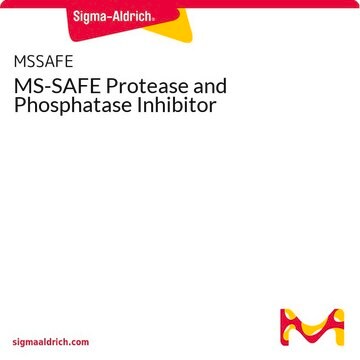P8340
Protease Inhibitor Cocktail
DMSO solution, for the inhibition of serine, cysteine, acid proteases and aminopeptidases, for use with mammalian cell and tissue extracts, DMSO solution
Synonym(s):
Protease Inhibitor Mix
About This Item
Recommended Products
product name
Protease Inhibitor Cocktail, for use with mammalian cell and tissue extracts, DMSO solution
biological source
bovine lung
Quality Level
form
DMSO solution
storage temp.
−20°C
Looking for similar products? Visit Product Comparison Guide
Related Categories
General description
Specificity
Application
Provides protection against endogenous enzyme activity in cell and tissue extracts
Biochem/physiol Actions
Features and Benefits
Stable storage: supplied as a solution in DMSO, allowing for long-term storage at -20°C
Consistent performance: ready-to-use solution
Components
Aprotinin
Bestatin
E-64
Leupeptin
Pepstatin A
Caution
Preparation Note
also commonly purchased with this product
related product
Signal Word
Warning
Hazard Statements
Precautionary Statements
Hazard Classifications
Eye Irrit. 2 - Skin Irrit. 2
Storage Class Code
10 - Combustible liquids
WGK
WGK 2
Flash Point(F)
188.6 °F - closed cup
Flash Point(C)
87 °C - closed cup
Certificates of Analysis (COA)
Search for Certificates of Analysis (COA) by entering the products Lot/Batch Number. Lot and Batch Numbers can be found on a product’s label following the words ‘Lot’ or ‘Batch’.
Already Own This Product?
Find documentation for the products that you have recently purchased in the Document Library.
Customers Also Viewed
Related Content
MILLIPLEX® panel multiplexes immune checkpoint molecules, aiding NSCLC research to identify immunotherapy targets for PD-1/PD-L1 therapy.
MILLIPLEX® panel multiplexes immune checkpoint molecules, aiding NSCLC research to identify immunotherapy targets for PD-1/PD-L1 therapy.
MILLIPLEX® panel multiplexes immune checkpoint molecules, aiding NSCLC research to identify immunotherapy targets for PD-1/PD-L1 therapy.
MILLIPLEX® panel multiplexes immune checkpoint molecules, aiding NSCLC research to identify immunotherapy targets for PD-1/PD-L1 therapy.
Our team of scientists has experience in all areas of research including Life Science, Material Science, Chemical Synthesis, Chromatography, Analytical and many others.
Contact Technical Service












